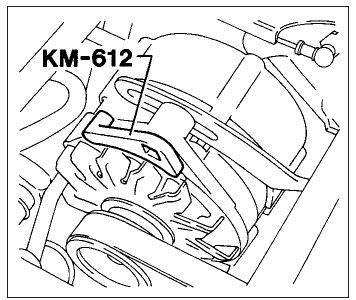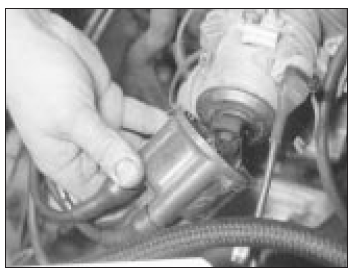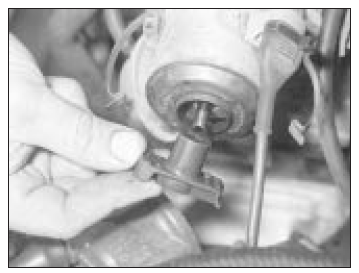Opel Corsa B 1993–2000 Service and Repair Manual: Auxiliary drivebelt check and renewal
Alternator drivebelt
Checking and adjustment
1. Correct tensioning of the auxiliary drivebelt will ensure that it has a long life. Beware, however, of overtightening, as this can cause excessive wear in the alternator.
2. The belt should be inspected along its entire length, and if it is found to be worn, frayed or cracked, it should be renewed as a precaution against breakage in service. It is advisable to carry a spare drivebelt of the correct type in the vehicle at all times.
3. Although special tools are available for measuring the belt tension, a good approximation can be achieved if the belt is tensioned so that there is approximately 13 mm of free movement under firm thumb pressure at the mid-point of the longest run between pulleys. If in doubt, err on the slack side, as an excessively-tight belt may cause damage to the alternator or other components.
4. If adjustment is required, loosen the alternator upper mounting nut and bolt - use two spanners, one to counterhold the bolt.
Lever the alternator away from the engine using a wooden lever at the mounting bracket until the correct tension is achieved, then tighten the bolt securing the adjuster bracket, and the alternator mounting nuts and bolts.
On no account lever at the free end of the alternator, as serious internal damage could be caused to the alternator.
Removal, renewal and refitting
5. To remove the belt, simply loosen the mounting nuts and bolts, and the bolt securing the adjuster bracket, as described previously, and slacken the belt sufficiently to slip it from the pulleys. On models with power steering it will first be necessary to remove the power steering pump drivebelt as described below.
6. Refit the belt, and tension it as described previously. Note that when a new belt has been fitted it will probably stretch slightly to start with and the tension should be rechecked, and if necessary adjusted, after about 5 minutes running.
Power steering pump drivebelt
Checking and adjustment
7. Refer to the information given in paragraphs 1 to 3, noting that there should be approximately 8 mm of free movement in the belt.
8. If adjustment is required, slacken the adjuster bolt locknut (situated on the base of the pump) and rotate the adjuster nut as necessary to tension the belt. Once the belt tension is correct, securely tighten the locknut.
Removal, renewal and refitting
9. To remove the belt, simply loosen the locknut and fully slacken the adjuster nut sufficiently to slip the drivebelt from the pulleys.
10. Refit the belt, and tension it as described previously. Note that when a new belt has been fitted it will probably stretch slightly to start with and the tension should be rechecked, and if necessary adjusted, after about 5 minutes running.
Alternator/power steering pump drivebelt - later 1.6 litre models
Checking and adjustment
11. From March 1987 onwards, a single drivebelt is used for the alternator and power steering pump on 1.6 litre engines. The drivebelt is of the ribbed type and runs at a higher tension than the previous (V) belt.
12. To set the tension accurately, make up or obtain an adapter as shown (see illustration).

Adapter KM-612 used for setting
drivebelt tension on later 1.6 litre models
13. Slacken the alternator pivot and adjusting strap bolts and fit the adapter. Using a torque wrench apply a load of 55 Nm (40 lbf ft) for a new belt, or 50 Nm (37 lbf ft) for an old belt.
Keep the tension applied and securely tighten the alternator bolts.
Removal, renewal and refitting
14. To remove the belt, simply loosen the alternator pivot and strap bolts and slip the drivebelt from the pulleys.
15. Refit the belt, and tension it as described previously. Note that when a new belt has been fitted it will probably stretch slightly to start with and the tension should be rechecked, and if necessary adjusted, after about 5 minutes running.
Ignition system check
Models with contact breaker ignition system
1. Renew the contact breaker points and adjust the gap and dwell angle. After adjustment put one or two drops of engine oil into the centre of the cam recess where appropriate and smear the surfaces of the cam itself with petroleum jelly.
Do not over-lubricate as any excess could get onto the contact point surfaces and cause ignition difficulties.
2. The spark plug (HT) leads should also be checked.
3. Ensure that the leads are numbered before removing them, if not make identification marks to avoid confusion when refitting. Pull the leads from the plugs by gripping the end fitting, not the lead, otherwise the lead connection may be fractured.
4. Check inside the end fitting for signs of corrosion, which will look like a white crusty powder. Push the end fitting back onto the spark plug ensuring that it is a tight fit on the plug. If not, remove the lead again and use pliers to carefully crimp the metal connector inside the end fitting until it fits securely on the end of the spark plug.
5. Using a clean rag, wipe the entire length of the lead to remove any built-up dirt and grease. Once the lead is clean, check for burns, cracks and other damage. Do not bend the lead excessively or pull the lead lengthwise - the conductor inside might break.
6. Disconnect the other end of the lead from the distributor cap. Again, pull only on the end fitting. Check for corrosion and a tight fit in the same manner as the spark plug end. If an ohmmeter is available, check the resistance of the lead by connecting the meter between the spark plug end of the lead and the segment inside the distributor cap. Refit the lead securely on completion.
7. Check the remaining leads one at a time, in the same way.
8. If new spark plug (HT) leads are required, purchase a set for your specific car and engine.
9. Remove the distributor cap, wipe it clean and carefully inspect it inside and out for signs of cracks, carbon tracks (tracking) and worn, burned or loose contacts; check that the cap's carbon brush is unworn, free to move against spring pressure and making good contact with the rotor arm. Also inspect the cap seal for signs of wear or damage and renew if necessary. Remove and inspect the rotor arm (see illustrations). It is common practice to renew the cap and rotor arm whenever new spark plug (HT) leads are fitted.
When fitting a new cap, remove the leads from the old cap one at a time and fit them to the new cap in the exact same location - do not simultaneously remove all the leads from the old cap or firing order confusion may occur. On refitting ensure that the arm is securely pressed onto the shaft and the cap is securely fitted.

Remove the distributor cap . . .

. . . and pull off the rotor arm from
the distributor shaft (1.6 litre model shown)
10. Even with the ignition system in first class condition, some engines may still occasionally experience poor starting attributable to damp ignition components. To disperse moisture a moister dispersant aerosal can be very effective.
Models with an electronic ignition system
Warning: Voltages produced by an electronic ignition system are considerably higher than those produced by conventional ignition systems. Extreme care must be taken when working on the system with the ignition switched on. Persons with surgically-implanted cardiac pacemaker devices should keep well clear of the ignition circuits, components and test equipment.
11. Check the condition of the HT leads and distributor components as described above in paragraphs 3 to 10.
12. Check the ignition timing.
 Hose and fluid leak check
Hose and fluid leak check
1. Visually inspect the engine joint faces,
gaskets and seals for any signs of water or oil
leaks. Pay particular attention to the areas
around the camshaft cover, cylinder head, oil
filter and su ...
 Idle speed and mixture
adjustments
Idle speed and mixture
adjustments
1. Before checking the idle speed and mixture
setting, always check first the following.
Check that the ignition timing is accurate.
Check that the spark plugs are in good condition and correct ...
See also:
Opel Corsa Owners Manual. Cruise control
The cruise control can store and
maintain speeds of approx. 30 (20) to
200 km/h (120 mph). Deviations from
the stored speeds may occur when
driving uphill or downhill.
For safety reasons the cr ...
